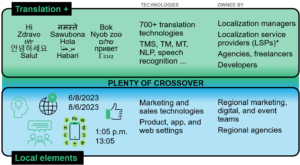The Optimization Of Localization
Ask any marketing leader in a given region, and they will tell you that global assets need frequent and, at times, extensive localization before they can be relevant to the needs of their local buying audience. Localization is not just about language — it is also about local elements such as imagery, thought leaders, customer references, market data, payments, date, and time formats … the list goes on.
 (figure depicting a sample of what is required for localization)
(figure depicting a sample of what is required for localization)
The State Of Localization
Localization is not just done by the marketing department either. “Unofficial” localization is done by the sales team, the legal team, the product team, tech support, the digital team — you get the picture. Often, this leads to multiple iterations of a single asset.
For the marketing team, they must layer the localization elements on top of the multiple assets that are produced at the corporate level (with the expectation of regional usage) and then couple that with the multiple different and distinct countries in the region, with their different languages, cultures, and nuances. The result is a big task in understanding where to prioritize your limited resources to give you the greatest return.
Localization Woes
To customers, every touchpoint is part of your brand. It is essential that each and every part of the buyer’s journey is relevant and applicable to them. But the challenge for regional marketing leaders is the lack of a grasp of how deep and how wide to go with localization when they often don’t have the full picture. In many cases, they have no understanding of the current coverage across the organization in all the iterations, limited insights into what to prioritize to give the greatest returns, and a siloed model of resources where marketing usually funds all the required localization (even if it’s not determined by marketing as necessary).
A Four-Step Approach To Localization Optimization
To guide regional marketing leaders on a process that makes it easier and clearer to understand what they need to do to optimize localization, we have developed a four-step process. These are the building blocks for a localization blueprint that will provide clarity on localization optimization:
- Understand buyer journeys and preferences. Understand what your buyers care about at different parts of the buyer’s journey.
- Inventory the current state of localization. Review the current localization state across touchpoints, and make an inventory of what you’re doing now.
- Review scope. Document new and recurring localization demands that are added annually.
- Assess readiness. Assess how well your technology and staffing meet localization requirements.
Join me at Forrester’s B2B Summit APAC event on September 19–20, where I will elaborate on how you can optimize localization in the region. This session will provide the following benefits:
- You’ll understand how to assess the current state in order to prioritize localization for optimal ROI.
- You will discover what competencies are needed across the marketing organization to optimize this approach.
Forrester’s B2B Summit APAC will deliver unique, region-focused, actionable, and best-practice-enabled guidance to support our clients to take bolder, bigger, and more impactful actions for their organizations but also for their personal growth and success. Our sessions are in line with our theme of “Adapt. Act. Grow” to ensure that we are equipping you with not just the “what to do” but also the “how to do it” as you take these learnings back to your organization.
We are excited to share these new strategic and operational insights and best practices at this year’s B2B Summit APAC and to continue to be by the side of our clients throughout the region. We can’t wait to see you there!
